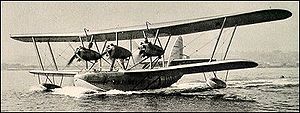Short S.8 Calcutta Video - Picture

|
|
Short S.8 Calcutta
S.8 Calcutta

Picture - View shows the pilot in the open cockpit
Role: Biplane airliner flying boat
Manufacturer: Short Brothers
First flight: 14 February 1928
Introduced: 1928
Primary user: Imperial Airways
Number built: 7
Developed from: Short Singapore
Variants: Short Rangoon
Breguet 521
The Short Calcutta or S.8 was a civilian biplane airliner flying boat made by Short Brothers.
Design and development
The Calcutta biplane flying boat originated from an Imperial Airways requirement to service the Mediterranean legs of its services to and from India. Derived from the Short Singapore military flying boat, the Calcutta was noteworthy for being the first stressed skin, metal-hulled flying boat. It was equipped with three Bristol Jupiter engines mounted between the wings. The two pilots flew the plane from an open cockpit while the radio operator shared the main cabin with the 15 passengers.
Operational history
The S.8 Calcutta made its first flight on 14 February 1928, having been launched the previous day and left at its mooring overnight to assess the hull for signs of leakage. Shorts' Chief Test Pilot, John Lankester Parker was at the controls, with Major Herbert G. Brackley of Imperial Airways as co-pilot. On 15 March 1928, this aircraft (registered as G-EBVG) was delivered by Parker and Brackley to the Marine Aircraft Experimental Establishment, Felixstowe, for its airworthiness and sea handling checks; these were successfully completed on 27 July of the same year and the aircraft was flown back to Shorts on the same day. G-EBVG was handed over to Imperial Airways on 9 August 1928.
The S.8 Calcutta was introduced in 1928 and was used by Imperial Airways flying the Mediterranean to Karachi leg of the Britain to India route.
A total of seven aircraft were built. A military version of the Calcutta, originally known as the Calcutta (Service type), was built as the Short Rangoon. In 1934, a Calcutta was purchased by the French Breguet Company from which they developed a military version for the French Navy known as the Breguet S.8/2, it was similar to the Rangoon version. Four aircraft were built under licence by Breguet at Le Havre. Breguet later developed an improved version the Breguet 521 Bizerte.
On 1 August 1928, Parker, accompanied by Oswald Short, flew G-EBVG to Westminster, setting it down on the Thames between Vauxhall and Lambeth Bridges; it was moored off the Albert Embankment for three days for inspection by Members of Parliament (including the then Chancellor of the Exchequer, Winston Churchill), members of the House of Lords and others.
Operators
United Kingdom
Imperial Airways
Specifications
Data from British Civil Aircraft 1919-1972:Volume III
General characteristics
Crew: 3
Capacity: 15
Length: 66 ft 9 in (20.35 m)
Wingspan: 93 ft 0 in (28.35 m)
Height: 23 ft 9 in (7.24 m)
Wing area: 1,825 ft² (170 m²)
Empty weight: 13,845 lb (6,293 kg)
Max takeoff weight: 22,500 lb (10,227 kg)
Powerplant: 3x— Bristol Jupiter IXF radial engine, 540 hp (403 kW) each
Performance
Maximum speed: 118 mph (103 kn, 190 km/h)
Cruise speed: 97 mph (84 kn, 156 km/h)
Range: 650 mi (565 nmi, 1,046 km)
Service ceiling: 13,500 ft (4,120 m)
Rate of climb: 750 ft/min (3.8 m/s)
Related development
Short Rangoon
Breguet 521 Bizerte
Bibliography
Barnes C.H. and D.N. James. Shorts Aircraft since 1900. London: Putnam, 1989. ISBN 0-85177-819-4.
The Illustrated Encyclopedia of Aircraft (Part Work 1982-1985). London: Orbis Publishing, 1985.
Jackson, A.J. British Civil Aircraft 1919-1972: Volume III. London: Putnam, 1988. ISBN 0-85177-818-6.
Short S.8 Calcutta Pictures
Living Warbirds: The best warbirds DVD series.
Source: WikiPedia